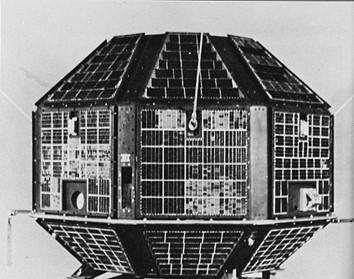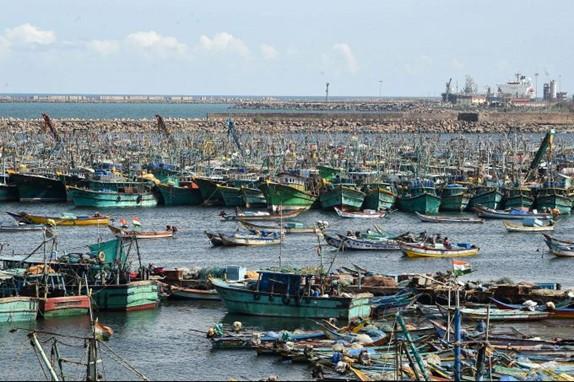Wednesday, 21st April 2021
National Civil Services Day
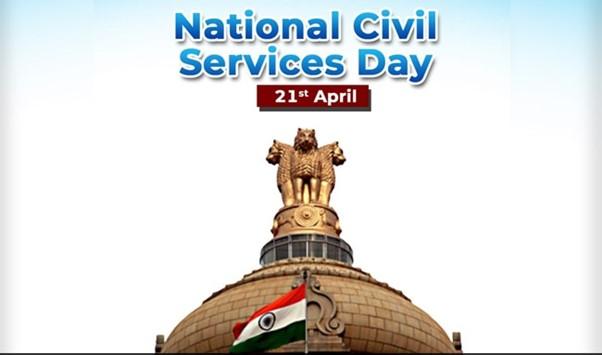
On April 21, 1947, India’s first home minister, Sardar Vallabhbhai Patel addressed the newly appointed Administrative Services Officers of newly independent India. The historic occasion took place at the Metcalf House in Delhi. Sardar Vallabhbhai Patel, had referred to the administrative officers as the ''steel frame of India'' or in other words the backbone of the country's administration. Sardar Patel, in his special address, laid out the golden rules and principles of good governance for the civil servants. So, to commemorate this day, India celebrates April 21 as the National Civil Services day every year.
Preparing for floods on the Third Pole
In News
A recent study has found that Satellite-based real-time monitoring of Himalayan glacial catchments would improve understanding of flood risk in the region
About the Study
- The study: The scientists aim to create a network of satellite-based monitoring stations that could provide in situ and real-time data on GLOF risk and help mitigate GLOF events in the future.
- Integration of monitoring devices with satellite networks can provide telemetry support in remote locations that lack complete cellular connectivity and provide greater connectivity in coverage in the cellular dead zones in extreme topographies such as valleys, cliffs, and steep slopes.
How will the study help?
- Strong network: Real-time data would help to develop a strong network of early flood warning systems in the glacierized catchment of the Himalayas.
- Timely Action: Real-time monitoring technologies would not only help to predict and warn of the impending danger and prevent loss of life, but would also allow scientists to monitor installed instruments remotely and take timely actions against any instrument malfunction, preventing the loss of vital data.
- Effects of Climate change: The enriched datasets will help us to better understand the effects of climate change on the Third Pole, which is often regarded as a “white spot” on the global map, indicating the presence of very limited continuous field hydrometeorological data,
Why is this study important for the Himalayan region?
- Increasing temperatures and human interventions have added stress on the Himalayan region's hydrological sensitivity and have increased the risks of major flood events. Increasing concern has been centered around glacial lake outburst floods (GLOFs) and cloudburst events.
- GLOFs occur when either a natural dam containing a glacial lake bursts or when the lake's level suddenly increases and overflows its banks, leading to catastrophic downstream destruction.
- The magnitude of these flooding events requires a more advanced adaptive measure. In particular, an effective early warning system that would warn local communities of impending flood danger is urgently needed.
NITI Aayog: Need evaluation of UN''s Sustainable Development Framework
In News
NITI Aayog Vice Chairman Rajiv Kumar stressed on the importance of an independent and comprehensive evaluation of UN''s Sustainable Development Framework (2018-22) and creating a new development cooperation framework for 2023-27 through multi-stakeholder engagement.
Key Highlights
- NITI Aayog members highlighted the need for a paradigm shift to address the nutrition challenge in India and taking a relook at the food components of diet.
- Significance of ‘vocal for local’ policy was emphasized for incentivizing the production and marketing of local food items, especially nutri-cereals.
|
Five-Year Sustainable Development Framework (2018-2022) Government of India-United Nations Sustainable Development Framework (SDF) 2018-2022 outlines the work of UN agencies in India to support the achievement of key development outcomes that have been identified in consultation with the government and are aligned to the national priorities.
The NITI Aayog is the national counterpart for the UN in India for the operationalisation of the UNSDF. The UNSDF 2018-22 comprises seven priority areas that outline the work that UN agencies will undertake jointly or individually, fully aligned with the priorities of the GoI. The seven priority areas outlined in the UNSDF are: 1. Poverty and Urbanization 2. Health, Water, and Sanitation 3. Education and Employability 4. Nutrition and Food Security 5. Climate Change, Clean Energy, and Disaster Resilience; 6. Skilling, Entrepreneurship, and Job Creation and 7. Gender Equality and Youth Development. |
NITI Aayog efforts to promote sustainable development
- SDG India Index: NITI Aayog has constructed the SDG India Index to track the progress of all the States and Union Territories (UTs) on a set of 17 Goals and 70 targets, measuring their progress on the outcomes of the interventions and schemes of the Government of India. The SDG India Index is intended to provide a holistic view on the social, economic and environmental status of the country and its States and UTs.
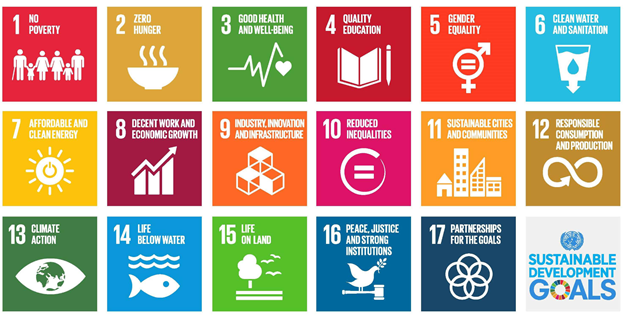
- Voluntary National Review: NITI Aayog has undertaken two Voluntary National Review (VNR) at the UN High-level Political Forum on Sustainable Development, 2020. The India VNR 2020 report titled Decade of Action: Taking SDGs from Global to Local was released in July last year.
- Promoting the role of states in attaining SDG: NITI Aayog has been driving states and Union Territories to put in place robust monitoring systems with the State Indicator Frameworks as the Foundation. States and UTs have been asked to develop their own SDG monitoring dashboards to track progress under their respective SIF and DIF.
Sources:
RBI sets up 6-member panel to review working of ARCs
In News
The Reserve Bank of India (RBI) has formed a six-member panel to examine the role of asset reconstruction companies (ARCs) in stressed debt resolution and review their business model.
What is an Asset Reconstruction Company (ARC)?
- It is a specialized financial institution that buys Non Performing Assets (NPAs)from banks and financial institutions so that they can clean up their balance sheets.
- ARC help consolidate and clean up all bad loans of banks under single exclusive entity thereby boosting entrepreneur’s confidence.
- It is registered with and regulated by RBI under the Securitization and Reconstruction of Financial Assets and Enforcement of Security Interest (SARFAESI) Act, 2002 (The SARFAESI Act helps reconstruction of bad assets without the intervention of courts).
- The ARCs also must maintain a capital adequacy ratio (CAR) of 15% of itsrisk weighted assets (CAR is the minimum amount of capital that must be held by banks and other financial institutions to reduce the risk of insolvency).
Status of ARCs
- While most of the ARCs remaining short on capital, only 3-4 are adequately capitalized. This necessitates the need to set up a new structure to resolve stressed assets urgently.
- ARCs are significant to revive India’s economy during and post Covid-19 pandemic. For the same reason, the Union Budget 2021-22 proposed new ARC/Bad bank to consolidate and take over the existing bad loans.
- Also, in the light of RBI report saying that banks' gross NPAs may rise from 7.5% in September 2020 to 13.5% by September 2021, the ARCs have gained prominence.
Primary source: https://taxguru.in/rbi/assets-reconstruction-company.html
NASA's experimental Mars helicopter Ingenuity

NASA's experimental Mars helicopter Ingenuity hovered above the surface of Mars on, April 19, 2021. The little 4-pound helicopter rose from the dusty red surface into the thin Martian air, achieving the first powered, controlled flight on another planet. Ingenuity is a technology demonstration to test powered flight on another world for the first time. It hitched a ride to Mars on the Perseverance rover. As an homage to the Wright brothers who succeeded in making the first flight on Earth, this first of many airfields on other worlds will now be known as Wright Brothers Field.
WTO Peace Clause
In News
Recently, India has invoked the peace clause at the World Trade Organization (WTO), for the second time, for exceeding the 10 per cent ceiling on support it offered its rice farmers.
More about the News
- India informed the WTO that the value of its rice production in 2019-20 was $46.07 billion while it gave subsidies of about 7 % as against the permitted 10 % under the Peace Clause.
- India had earlier invoked the clause for 2018-19, when it became the first country to do so.
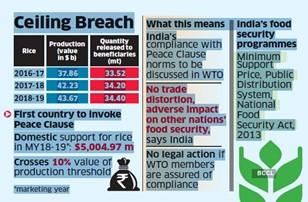
Why does India invoke the Peace Clause and is it justified?
- To ensure Food Security: India ensures food security through the minimum support price (MSP) programme, and Public Distribution System and National Food Security Act, 2013.
- The main objectives of the food security programmes are ensuring MSP to farmers, stability in food grain prices and their equitable distribution at affordable prices to the marginalised, maintaining an adequate buffer stock of foodgrains to deal with unforeseen circumstances.
- Justified as per the Bali agreement: India's breach of commitment for rice, under the Agreement on Agriculture arises from support provided in pursuance of public stockholding programmes for food security purposes, under the Bali Ministerial Decision on Public Stockholding for Food Security Purposes.
- Not distorting international trade: Government does not undertake exports on a commercial basis from public stockholdings. Additionally, open market sales of food grains from public stockholding are provided to the buyer with the undertaking of not exporting the purchase.
What is the Peace Clause?
- Agreement on Agriculture (AOA): The Peace Clause is part of the AOA. Under the Clause, the WTO Agreement on Agriculture allows developing countries to provide price support and public stockholding for food security, if the stocks are acquired to support low income and resource poor producers.
- The WTO rules allow subsidization of these food security programs as long as total domestic agricultural subsidies by developing countries do not exceed 10% of the total agricultural output.
- Need for the Peace Clause: Without this “peace clause”, countries would have greater freedom to take action against each other’s’ subsidies, under the Subsidies and Countervailing Measures Agreement and related provisions.
- The peace clause protects India’s food procurement programmes against action from WTO members in case the subsidy ceilings of the value of food production are breached.
What is the Agreement on Agriculture and the Subsidies?
- Aim: The AoA aims to establish a fairer trading system that will increase market access and improve the livelihoods of farmers around the world.
- Components: The AoA stands on three major components for fair trade systems, which are Market Access, Domestic Support and Export subsidies. The Domestic support part of the AoA includes the subsidies, which are concerned with the Peace Clause.
- Domestic support refers to the government subsidies that guaranteed Minimum Price (or Input subsidies) which are provided at the domestic level either directly or product-specific or both.
- The Subsidies: The subsidy regime is divided into three boxes Blue, Amber, and Green depending on the degree of subsidy being provided. Those considered non-distorting are listed in the green box, the minimally distorting ones come under the blue box while subsidies seen as causing serious market distortions are categorised as amber box
- Amber box limits the subsidies like support prices, or subsidies directly related to production quantities up to 5% for developed nations and 10% for developing ones.
Why has the subsidy and the Peace clause become a bone of contention at the WTO?
- Three problematic biases in the WTO rules:
- External Reference Price: Using the unit value of imports or exports over a fixed past period (1986-88 for most countries) as the External Reference Price (ERP) instead of using the current price. Because of that artificially low price, a barely above-market price today can look like a massive subsidy when compared to the outdated reference price.
- Price Support: Using the procurement price instead of the price prevailing in the domestic market to estimate the price support received by the farmers. The implicit assumption is that the public procurement price sets the domestic price whereas in many cases the quantity procured may be too small to affect the domestic price.
- Total Production: Using the total production instead of the quantity sold to estimate the support received by farmers. The WTO rules, again, mistakenly assume that farmers sell all their production without keeping back anything for their own consumption. Obviously, this is not the case in developing countries, especially for staple food grains.
- Skewed nature of many agreements: The genesis of the problem lies in the skewed nature of many agreements, including the AOA.
- Nearly all the rich countries’ subsidies fall into the green box while those of developing nations are mostly in the amber There is no expenditure limit on the subsidies that fall into the first two boxes(green and blue), while the amber box subsidies have to be limited to 10 % of the value of agricultural production for developing countries and 5 per cent for developed countries.
- Example: USA had shifted most of its farm subsidies (88 per cent) into the green Thus, the US has been subsidising its corporate agriculture to capture global markets while the subsidies India gives to an overwhelmingly large share of small and marginal farmers.
- Unfair restrictions on developing countries: The current trade rules can prevent developing countries from adopting policies that have been shown to be effective in developed countries when they were at earlier stages of development. For example, measures that India is now pursuing: supported farm prices, public stockholding, managed domestic markets, and public support for food purchases were used in past decades by some developed countries because they worked.
What can be done to bring balance between India’s needs and WTO regulations?
- India’s Proposal: India has asked for a permanent solution on public stock holding for food security purposes on priority. A decision on this issue will signal WTO’s commitment to the UN Sustainable Development Goals and the fight against hunger and malnourishment. The permanent solution has to be an improvement over the perpetual peace clause, which was adopted in Bali MC-9 to continue with the existing level of subsidies till the permanent solution is found.
- Way Forward: Conventional analysis suggests that policymakers should use targeted non-trade policies to offset potential negative impacts of trade reform.
- A country’s capacity to take such a step depends on whether effective institutional mechanisms are in place and, if not, the timeframe over which they can be developed.
- To avoid over- dependency on institutional markets, for example, public procurement programmes, producers can be encouraged to graduate from state food purchasing programs and become more competitive in the broader market.
Sources:
http://www.fao.org/3/i3658e/i3658e.pdf
https://www.downtoearth.org.in/news/agriculture/wto-s-assault-on-india-67667
https://thewire.in/agriculture/agriculture-ordinance-wto-india-farmers-msp-apmc
https://thewire.in/agriculture/the-pandoras-box-of-agri-reform-subsidies-and-tariffs
Counter Cyclical Capital Buffer (CCCB)
- Context: Recently, RBI has decided not to activate Counter Cyclical Capital Buffer.
- CCCB is a financial tool to help banks sail through distressed economic conditions.
- As the name suggests, it is a capital buffer which is staggered by the bank during good times, to be later used to distribute loans during times of financial crunch.
- With the CCCB, banks are required to set aside a higher portion of their capital (buffer) during good times when loans are growing rapidly, so that the capital can be released when there’s distress in the economy.
- It restricts the banking sector from indiscriminate lending in the period of excess credit growth.
- CCCB is calculated as a fixed percentage of a bank’s risk-weighted loan book.
- RBI had proposed the CCCB for Indian banks in 2015 as part of its Basel-III requirements, but it kept the CCCB at zero per cent ever since.
Primary source: https://www.thehindubusinessline.com/opinion/columns/slate/all-you-wanted-to-know-about-counter-cyclical-capital-buffer/article31272664.ece
Table Mountain National Park
- Context: An "out of control" fire has been burning in Cape Town's Table Mountain National Park, damaging buildings and prompting the evacuation of hikers.

- Designated as one of the most iconic landmarks of South Africa, the Table Mountain National Park also encompasses Cape of Good Hope, the south-western edge of South Africa.
- This natural world heritage site houses the Cape Floral region which is one of the richest floral zones in the world with over 70% flowers endemic to the region.
Primary source: https://www.sanparks.org/parks/table_mountain/conservation/fauna.php
Dhruv Mk III aircraft
- Context: First unit of indigenously-built chopper ALH (Advanced Light Helicopter) Dhruv Mk III aircraft has been inducted into the Indian Navy.

- ALH-DHRUV is a twin engine (named shakti), multi-role, multi-mission new generation helicopter manufactured by HAL.
- The Mk III version has advanced automatic flight control system and a 0.7mm gun. Dhruv could be used for low visibility search and rescue, special operations, and coastal surveillance.
Primary source: https://indianexpress.com/article/india/first-unit-of-indigeneously-built-chopper-alh-inducted-into-navy-7280793/
A low-carbon future through sector-led change – The Hindu
Essence - Amidst a call for global carbon emissions to reach net-zero by 2050 at various international fora, India faces a tough task of balancing the net-zero commitment and contributing to limit global temperature rise below 1.5°C with its own developmental needs. In this context, this article suggests focusing on sectoral low-carbon development pathways that combine competitiveness, job- creation, distributional justice and low pollution in key areas where India is already changing rapidly.
Why you should read this article?
- Understand how India can decarbonise the electricity sector through steps like announcing ceiling for coal power, creation of a multi-stakeholder Just Transition Commission, addressing existing problems of the sector and invest in future technologies.
- Know about the advantages of enhancing the efficiency of electricity use, replicating such an approach in other sectors and committing to plausible pathways and timelines to achieve net-zero emission.
India and Russia look for a reset – The Hindu
Essence - P.S. Raghavan, former Indian Ambassador to Russia is presenting analysis on India Russia relations in backdrop of recent visit by Russian Foreign Minister Sergey Lavrov. Principal objective was to prepare the ground for the visit of President Vladimir Putin later this year.
Russian side had been apprehensive over a U.S.-led Indo-Pacific policy, drawing India into “anti-China games” and undermining the India-Russia partnership. India’s has concerns about Russia’s China embrace, encompassing close political, economic and defence cooperation (Russia accounted for 77% of China’s arms imports in 2016-20). With Russia’s increasing defence supplies to Pakistan, we should know that sustainable defence cooperation is based on a credible assurance that what is transferred to our adversaries will not blunt the effectiveness of our weapons systems.
Eurasian landmass to India’s north is dominated by Russia and China. Strategic and security interests in Central Asia, West Asia and Afghanistan dictate our engagement with the region, geography is critical in geopolitics. The Modi-Putin summit later this year will tackle the “irritants” and, as before, will probably announce that perspectives have been reconciled.
Why you should read this article?
- To know about some differences in India & Russia relations, as gauged by recent visit of Russian foreign minister.
- To know about India’s efforts to connect with Far East of Russia. How Russia remains a time tested friend, enagaging in energy projects, and defence cooperation.
- To know issues related to defence imports & how Russia embracing Pakistan on counter terrorism measures can be more than a kind gesture.
- To learn why Russia is focusing on Asia Pacific and avoiding discussions about the Indo-Pacific region.
Link - https://www.thehindu.com/opinion/op-ed/india-and-russia-look-for-a-reset/article34361484.ece
Open Defecation Free Villages: Sustaining Nirmal Grams through Community Participation in Jharkhand
Present Situation
- 2011 Census has thrown up glaring data on India’s “missing toilets” with only 35% of the rural population using functional toilets
- Sanitation has become one of the biggest social sector service delivery challenges in India.
- In Jharkhand, rural population using functional toilets was even wider.
Nirmal Gram in Jharkhand
- Government of Jharkhand has created and sustained Nirmal Grams through a people-centric, participatory and demand-driven approach.
- It aims to create Open Defecation Free villages through the construction of a functional toilet in every household.
- The initiative is being scaled up across the state with convergence and community involvement
- The initiative has created a ripple effect as neighbouring villages have emulated the process and the State government has upscaled the initiative
Outcome
- Positive ripple effect in achieving ODF status across different states as well
- Building of Social Capital with community participation in the programme
- Control of communicable disease due to better sanitation facilities
Where can we use this case study?
Innovative Case Study to improve sanitation practises, eliminate manual scavenging, building social capital, to make a state Open Defecation Free.
Share the article
Get Latest Updates on Offers, Event dates, and free Mentorship sessions.

Get in touch with our Expert Academic Counsellors 👋
FAQs
UPSC Daily Current Affairs focuses on learning current events on a daily basis. An aspirant needs to study regular and updated information about current events, news, and relevant topics that are important for UPSC aspirants. It covers national and international affairs, government policies, socio-economic issues, science and technology advancements, and more.
UPSC Daily Current Affairs provides aspirants with a concise and comprehensive overview of the latest happenings and developments across various fields. It helps aspirants stay updated with current affairs and provides them with valuable insights and analysis, which are essential for answering questions in the UPSC examinations. It enhances their knowledge, analytical skills, and ability to connect current affairs with the UPSC syllabus.
UPSC Daily Current Affairs covers a wide range of topics, including politics, economics, science and technology, environment, social issues, governance, international relations, and more. It offers news summaries, in-depth analyses, editorials, opinion pieces, and relevant study materials. It also provides practice questions and quizzes to help aspirants test their understanding of current affairs.
Edukemy's UPSC Daily Current Affairs can be accessed through:
- UPSC Daily Current Affairs can be accessed through Current Affairs tab at the top of the Main Page of Edukemy.
- Edukemy Mobile app: The Daily Current Affairs can also be access through Edukemy Mobile App.
- Social media: Follow Edukemy’s official social media accounts or pages that provide UPSC Daily Current Affairs updates, including Facebook, Twitter, or Telegram channels.


